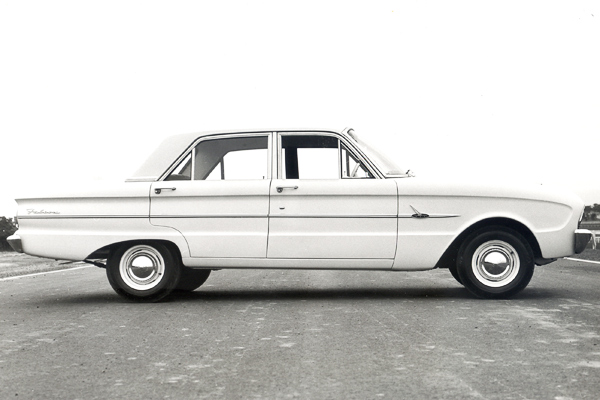 Ford Australia needed to come up with a car that was able to compete with the successful Holden, While looking at the American designed Ford Zephyr Ford Australia bosses decided that the styling of it did not appeal to them enough, so they decided to have a look at the American Designed Ford Falcon, and it was decided that the Falcon was perfect for the Australian market.
Ford Australia needed to come up with a car that was able to compete with the successful Holden, While looking at the American designed Ford Zephyr Ford Australia bosses decided that the styling of it did not appeal to them enough, so they decided to have a look at the American Designed Ford Falcon, and it was decided that the Falcon was perfect for the Australian market.
The XK Ford Falcon was designed to compete with the popular rival FB Holden,. The XK had much more cleaner, lower and wider lines then its rival making it a very popular choice of car at the time. The XK Falcon came out with a 144 Cubic Inch 90 bhp 6 cylinder engine with a 3 speed column shit manual standard or an optioned 2 speed automatic.
By the end of may 1961 the Falcon was available in sedan, wagon, ute and panel van. The problems that Ford Australia had with this model was the car was designed and tested in America and wasn’t designed for our rough country roads, causing suspension problems. The tyres were to small and the car wasn’t powerful enough for the Australian market, so later in the year the 170 Pursuit engine was introduced.
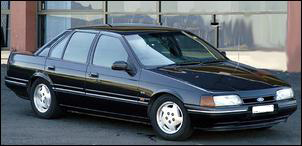 Trim, Taught and Terrific, the slogan for the facelifted Falcon which was badged as the XL. A big first for the Falcon was that the car came with seatbelt attachments, but seatbelts were still an option. The car was given a more square roofline known as the Thunderbird look. Two more models were added to the Falcon range including the Futura which gave you a padded dash, full carpet and bucket seats. The other model added was the Squire Wagon, which was a very American looking fake woodie. It had fake wooden panels on the sides made out of fiberglass. These Squire wagons are very collectable as there was only 728 made. The suspension and clutch were reworked in the XL making a huge improvement from the XK Falcon, aswell as a higher second gear ratio meaning approved acceleration at lower speeds. Although all of these things were supposedly fixed and better then the XK, the problems were still all there.
Trim, Taught and Terrific, the slogan for the facelifted Falcon which was badged as the XL. A big first for the Falcon was that the car came with seatbelt attachments, but seatbelts were still an option. The car was given a more square roofline known as the Thunderbird look. Two more models were added to the Falcon range including the Futura which gave you a padded dash, full carpet and bucket seats. The other model added was the Squire Wagon, which was a very American looking fake woodie. It had fake wooden panels on the sides made out of fiberglass. These Squire wagons are very collectable as there was only 728 made. The suspension and clutch were reworked in the XL making a huge improvement from the XK Falcon, aswell as a higher second gear ratio meaning approved acceleration at lower speeds. Although all of these things were supposedly fixed and better then the XK, the problems were still all there.
In February 1964 the XM Falcon was introduced, it was a facelifted version of the XL, which had a newer looking front end and plenty of chrome. Another new addition was added to the range which was called the Hardtop, which was a two door version of the XM. Big changes were made under the bonnet, with an all new Super Pursuit engine being offered with 121bhp and it was 200 Cubic inches. The manual super pursuit was able to reach 100kmh in 11.1 seconds, which was quite quick for that time. This model was a great improvement because all of the suspension problems were fixed and everything was made stronger to deal with Australia’s country roads.
When the XP was introduced in 1965 Ford Australia wanted to put it to a big test, they wanted to clock up 70000 miles in 8 days, driving cars around its test track constantly. Five cars were put to the test and all 5 of the cars made it, even know they were bruised and battered, the cars were fine mechanically. This test helped the XP Falcon to win wheels car of the year. The body was strengthened and suspension was improved again to make the car better. A new Borg Warner 3 speed automatic was introduced. Small changes were made to the outside and inside of the car which included wrap around bumpers and a horizontal bar type grille, legroom was increased inside and the seats were widened. In September 1965 the Fairmont was introduced and it replaced the Futura and the very unpopular Squire Wagon. The Fairmont was introduced to compete with Holden’s Premier and it had reclining bucket seats, the Super Pursuit engine with the Borg Warner 3 speed auto aswell as disk brakes on the front, which was a first for an Australian built car.
To match the standard of living, Ford introduced the all new bigger and better XR Falcon. The XR was designed ion Australia but it was still based on the American Falcon. The new XR Falcon came with an option of a V8 engine, the 289cubic inch V8 had 200bhp and the 170 and 200 cubic inch 6 cylinder engines were still offered. The wheelbase was stretched and the small 13 inch wheels were replaced by 14 inch wheels, disk brakes were offered in all models. For the second time, Falcon won Wheels Car of the year award. The instrument panel was redesigned and lap belts were made standard in the front seats. The additions to the options list included a remote boot release and a stereo tape player.
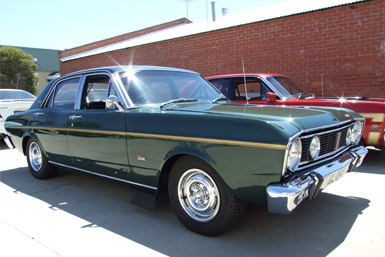 With the XT Falcon most of the changes came under the bonnet. With the capacities changed into litres instead of cubic inches, the Falcon range now offered a 3.1L and 3.6L 6 cylinders, and the new 4.9L V8. The engines were all made more reliable and quieter and they had improved fuel economy. The new engines were more suited to a big family car, which made the XT a lot faster and smoother then the previous XR Falcon. The 3 speed manual now had a syncromesh on the first gear and that joined the rest of Fords standard Transmissions. Many new safety features were added including split system brakes, larger tyres, an external mirror, windscreen washers and reversing lights. Not many changes were made to the car on the outside, minor things like the grille and tail lights were changed, inside the bench seat was still standard in the front, but bucket seats were more sort after and most cars were optioned with them.
With the XT Falcon most of the changes came under the bonnet. With the capacities changed into litres instead of cubic inches, the Falcon range now offered a 3.1L and 3.6L 6 cylinders, and the new 4.9L V8. The engines were all made more reliable and quieter and they had improved fuel economy. The new engines were more suited to a big family car, which made the XT a lot faster and smoother then the previous XR Falcon. The 3 speed manual now had a syncromesh on the first gear and that joined the rest of Fords standard Transmissions. Many new safety features were added including split system brakes, larger tyres, an external mirror, windscreen washers and reversing lights. Not many changes were made to the car on the outside, minor things like the grille and tail lights were changed, inside the bench seat was still standard in the front, but bucket seats were more sort after and most cars were optioned with them.
When the XW Falcon was introduced some people thought it was a completely new Falcon due to its different appearance. The front of the XW looked very bold with its grille in between the round headlights and the badge off to one side. For the first time tail lights were square shaped, instead of the usual round ones. The newly designed interior was said to have looked like a cockpit of a jet airliner, with its square dash and rubberized controls.
Slight power increases were made to all of the engine options and 3.6L buyers now had the option of a 4 speed floor shift manual. The Futura was bought back to life and the GS (Grand Sports) package was introduced. The GS was like a build it yourself version of the GT, it came with orange stripes, chrome wheel covers and the GT wooden steering wheels and full instrumentation.
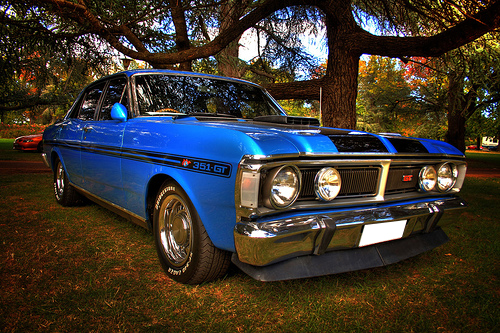 The introduction of the XY Falcon saw a bigger range of 6 cylinder motors, the 3.1L and 3.6L motors were scrapped and were replaced by the 3.3L and the 4.1L. More pulling power and torque came along with these new motors which suited people who towed. The big 5.8L 351 V8 was now offered in all models but it wasn’t as highly tuned as the ones in the GT Falcon. The old Fordomatic was dumped and the Cruiseomatic was made the main auto transmission. A safety plastic grille was added, aswell as restyled tail lights. A unique 4WD ute was offered, it was a good idea but not a good vehicle. Ground clearance was high, but the suspension was very rough and it had the turning circle bigger then the road. Only 432 of these utes were made and they are now a collectors item. The XY is one of the all time favorite Australian built cars.
The introduction of the XY Falcon saw a bigger range of 6 cylinder motors, the 3.1L and 3.6L motors were scrapped and were replaced by the 3.3L and the 4.1L. More pulling power and torque came along with these new motors which suited people who towed. The big 5.8L 351 V8 was now offered in all models but it wasn’t as highly tuned as the ones in the GT Falcon. The old Fordomatic was dumped and the Cruiseomatic was made the main auto transmission. A safety plastic grille was added, aswell as restyled tail lights. A unique 4WD ute was offered, it was a good idea but not a good vehicle. Ground clearance was high, but the suspension was very rough and it had the turning circle bigger then the road. Only 432 of these utes were made and they are now a collectors item. The XY is one of the all time favorite Australian built cars.
The XA Falcon was the first of the Falcons to be designed and built in Australia. One of the problems that drivers of the XA had was vision problems, especially out the rear window as the rear seat was very high. The usual sedan, wagon, Ute and panelvan were joined by a two door coupe, which was bought in to compete with the Holden Monaro. The Hardtop coupe was available as a standard Falcon with normal skinny tyres which really let its looks down, or as a GT with fat tyres that filled the guards well. A heater and rear seat belts were now standard across the Falcon range and high back bucket seats were optional, except for Fairmont’s where they came standard. Even know the XA was a handful to steer, not many people optioned their cars up with the power steering.
The extremely popular XB had a very pronounced nose due to the new design of the bonnet which gave the car an even longer look. With newly designed bumpers and tail lights, the XB was given more of a muscle car image. For the first time in the history of the Falcon front disk brakes were standard and a full synchromesh manual gearbox was standard as well as inertia reel seat belts. In the list of options that Ford offered for the XB carpet and a rearward facing bench seat for the boot of the wagons were the most popular ones purchased by the buyers. The XB lasted almost 3 years in production and had record numbers of sales.
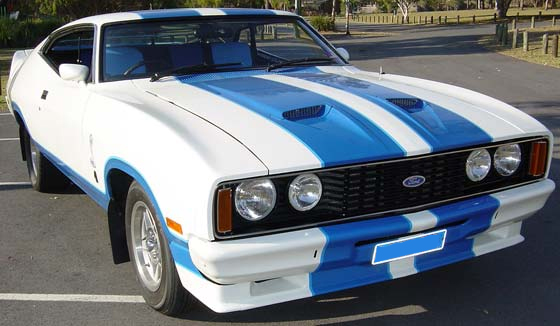 With the XC Falcon came the Governments new ADR27A rules, which meant cars now, had to be more efficient and environmentally friendly. The 6 cylinder Falcon motors were redeveloped to run smoother and got a new cross flow cylinder head. The GT name didn’t make it to the XC’s; the closest thing you could get was a Fairmont GXL, which had a V8 optional. The XC got a square looking grille, new bumpers and revised tail lights, the Fairmont received big square headlights, where as the rest still featured round headlights. A redesigned instrument panel made the interior look more fresh and welcoming. In May 1978 the XC ½ was introduced in order to compete with Holden’s new Radial Tuned Suspension, so Ford re did the whole suspension in the XC and made it handle heaps better and stick to the road better. The way to identify a XC ½ is by the blue Ford badge in the centre of the grille instead of the Ford letters across the bonnet.
With the XC Falcon came the Governments new ADR27A rules, which meant cars now, had to be more efficient and environmentally friendly. The 6 cylinder Falcon motors were redeveloped to run smoother and got a new cross flow cylinder head. The GT name didn’t make it to the XC’s; the closest thing you could get was a Fairmont GXL, which had a V8 optional. The XC got a square looking grille, new bumpers and revised tail lights, the Fairmont received big square headlights, where as the rest still featured round headlights. A redesigned instrument panel made the interior look more fresh and welcoming. In May 1978 the XC ½ was introduced in order to compete with Holden’s new Radial Tuned Suspension, so Ford re did the whole suspension in the XC and made it handle heaps better and stick to the road better. The way to identify a XC ½ is by the blue Ford badge in the centre of the grille instead of the Ford letters across the bonnet.
When the XD came along Ford was having trouble with making the car light enough, so they used aluminum where possible as well as lots of plastic being used. The energy absorbing bumpers, front grille and for the first time in an Australian built car, the fuel tank was also made out of plastic. Even know the XD was a lot smaller then the XC, the interior had just as much space due to its more efficient layout. There was a new electronic cable less Speedo and fashionable see through headrests which really drew the attention of buyers. Two things that carried on from the previous Falcons that buyers did not like were the umbrella handbrake as well as the horn being on the indicator stalk. The model range was simplified to the GL, Fairmont and new up market Fairmont Ghia, which gave you full interior electrics, velour trim and alloy wheels. In June 1980 the XD ½ was introduced which gave you electronic ignition and an alloy cylinder head which was designed and engineered by Honda. The ESP (European Sports Pack) was introduced with the XD ½ which gave you fog lights, Globe alloy wheels, body colored grille and a front spoiler. Suspension upgrades helped the ESP handle better and it was considered to be a modern version of the GT.
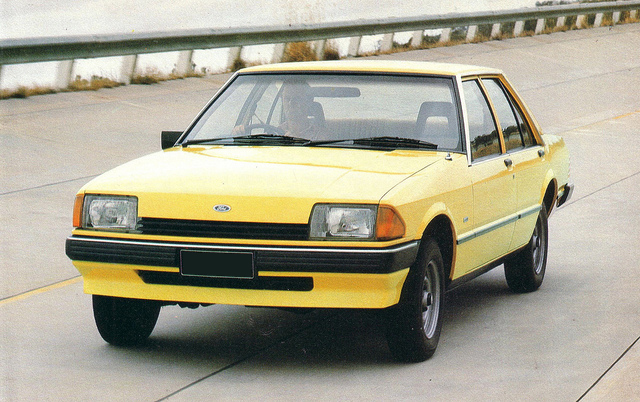 The XE Falcon helped Ford get the title of Australia’s best selling car, with many Falcons being sold through the time the XE was built. In November 1982 Ford rolled its last V8 out of the factory, ending a 50 year run of V8 Fords in Australia. Electronic fuel injection became an option on the Falcons and it also gave the car a 13kw power increase. Since 1960 the Falcon had a leaf spring rear end, but the XE was the first to have coils all around as well as a Watts Link rear suspension set up. By doing this the car handled a lot better, but the Wagon and Ute missed out on this suspension upgrade. The bonnet was redesigned to lip over the front of the car to meet the grille and the tail lights gained more flutes in them. With power steering still being an option, drivers still had to struggle with 5.2 turns lock to lock.
The XE Falcon helped Ford get the title of Australia’s best selling car, with many Falcons being sold through the time the XE was built. In November 1982 Ford rolled its last V8 out of the factory, ending a 50 year run of V8 Fords in Australia. Electronic fuel injection became an option on the Falcons and it also gave the car a 13kw power increase. Since 1960 the Falcon had a leaf spring rear end, but the XE was the first to have coils all around as well as a Watts Link rear suspension set up. By doing this the car handled a lot better, but the Wagon and Ute missed out on this suspension upgrade. The bonnet was redesigned to lip over the front of the car to meet the grille and the tail lights gained more flutes in them. With power steering still being an option, drivers still had to struggle with 5.2 turns lock to lock.
When the XF was bought into the market it featured an all new softer styled front end with a more rounded look. For the first time the Falcons front blinkers were incorporated into the headlights and this added a more modern look to the car. The new color coded interior made the car look more up market and the Fairmont Ghia gained a lot of new electric components including a trip computer, climate control and a full digital dash. In January 1986 it became compulsory for cars to run on unleaded fuel which meant Ford had to revise its engines and this resulted in small power drops across the engine range. When the XF ½ was introduced it gave power steering and 4 wheel disk brakes standard across the range and the Fairmont Ghia wagon was introduced.
When Ford designed the all new EA Falcon, they sent the prototype over to Germany to display next to the new BMW and Mercedes of the time, and the EA Falcon was a big hit with the Germans. So Ford Australia decided to keep their design and produce the EA as it was. With an all new car came all new problems, including welding problems with seams not being sealed properly and ECU problems with faulty computer chips which caused engine management troubles. Luckly these problems were discovered before the car was launched to the public and most of the problems were fixed. Front suspension issues and poor quality of paint work were other issues that the early EA Falcons had. The EA was offered with a 3.2L engine that had poor performance so it was quickly dropped from the option list, it is very hard to find a replacement 3.2L motor now as not many were produced. The other 3.9L 6 cylinder that was offered could out perform the old 351 V8, but the Falcon was still only offered with a 3 speed manual or a standard 5 speed manual. Power rack and pinion steering was now introduced to the Falcon range which gave the car a much tighter turning circle. In October 1989 a 4 speed auto was finally introduced, but the umbrella handbrake still lived on. The EA was only sold as a sedan or wagon, you could still get a Ute but it was still a XF.
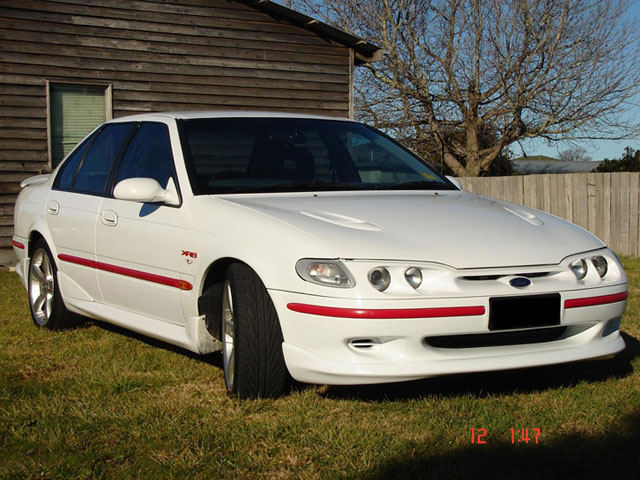 With the EB came the return of the V8 in the Falcons, the fuel injected 5L V8 was a big hit across the range. Not many visual changes came with the EB, mainly the Ford badge was now in the front grille and the reverse lights were on wither side of the rear number plate. The EB series 2 got a new, quieter 4.0L multi point 6 cylinder engines. Optional ABS brakes were now offered across the range to help keep the occupants of the car safer. Tickford Vehicle Engineering was introduced and one of the first models to arrive from them was the S XR6. The S XR6 gained power from the Tickford engineered cylinder head and a month after the S XR6 was introduced, the EB GT was unveiled in order to celebrate 25 years of GT. By the end of 1992 all of the Falcons had the new Smartlock security system which made the Falcons virtually unstealable.
With the EB came the return of the V8 in the Falcons, the fuel injected 5L V8 was a big hit across the range. Not many visual changes came with the EB, mainly the Ford badge was now in the front grille and the reverse lights were on wither side of the rear number plate. The EB series 2 got a new, quieter 4.0L multi point 6 cylinder engines. Optional ABS brakes were now offered across the range to help keep the occupants of the car safer. Tickford Vehicle Engineering was introduced and one of the first models to arrive from them was the S XR6. The S XR6 gained power from the Tickford engineered cylinder head and a month after the S XR6 was introduced, the EB GT was unveiled in order to celebrate 25 years of GT. By the end of 1992 all of the Falcons had the new Smartlock security system which made the Falcons virtually unstealable.
The only reason the ED was released was to compete with Holden’s best selling Commodore, as the Face lifted EF was still over a year away. The XR6 and XR8 gained a new grille that stretched across the whole front of the car as well as quad round headlights. The Xr8 Sprint was released and didn’t really stand out from the other XR8’s, it had different wheels and black inserts instead of red, it mainly relied on its performance as it shared the same power as the EB GT. Only 300 of these Sprints were made and they are now a collector’s item. The Futura was re introduced and came with ABS, cruise control and a 8 speaker stereo. On the exterior the Futura gained different wheels and body colored mirrors. With the ED came the dropping of the Fairmont Ghia wagon.
The face lifted EF Falcon was so much different to the previous models, the only thing that it shared with the previous E series models was the doors. The GLI and Futura no longer had a grille in between the headlights; all it had was the Ford oval badge. Fairmont and Fairmont Ghia got different shaped headlights and a fake grille incorporated into the bonnet, the XR’s managed to keep their trademark quad headlight front end. Alloy wheels and a Tickford body kit were made optional across the whole range. The rear end of the Falcon wagon carried over from the ED, with the only noticeable change being the design of the rear badge. Cup holders were standard across all models which were something that Ford buyers had been requesting for years. The Falcons awkward umbrella handbrake was finally dropped and the handbrake was now placed next to the driver on the side of the centre console. For the first time all Falcons had an electronic boot and fuel door release, which were often pressed accidentally when putting the key in the ignition. Ford paid a lot of attention to safety and for the first time an airbag was apart of the Falcon which added a lot more safety for the driver, the roof was also reinforced which helped if the vehicle was to roll over. The Smart Bar was introduced which was a bull bar which was designed to work with the airbag; this was a very popular factory fitted option for those who did a lot of country driving. This was a world first release. When the EF II was introduced an optional passenger airbag was offered, not only did this protect the passenger, but also the person in the front middle seat of a bench seat GLI Falcon. The Fairmont Ghia benefited most from this series II upgrade, it gained the XR6 engine and lowered suspension, leather trim and more chrome throughout the whole car. The not so popular XR6 wagon was dropped when the series II was released
The last of the E series Falcons was the EL, which gave the GLi and Futura models there front grille back. The GLI and Futuras also feature new headlights, bumpers and bonnets, giving the car a more rounded look at the front. The Fairmont models got a new stylish front chrome grille and the XR’s received a new look to their quad headlight front which gave it a more aggressive look. The suspensions for all of the EL’s were developed by a Tickford engineer which gave all of the EL’s a smoother ride and more solid handling. The Fairmont Ghia gained speed sensitive steering which made it less effort for parking.
.jpg) The AU Falcon was an all new car, but it wasn’t the best looking car, many people thought that it was quite ugly. Many people described the new AU as appearing droopy and sad. The front of the AU was designed to be extremely aerodynamic, and was meant to look bold. Each of the AU models could be told apart by the different grilles at the front, each model had its own unique grille. The Fairmont’s were given a different bonnet to the rest if the standard models in order to make it look more appealing to the up market car buyers, and the XR kept its traditional quad headlight front, and they gained flashy body kits and there was even an option for a twin spoiler for the boot lid. When the AU was designed, Ford Australia finally designed an all new Ute for the buyers, the previous Ute style dated back to the late 1970’s. When the interior was designed Ford didn’t want all of the instruments and buttons to be angled towards the driver, so in the end it all looked kind of messy and cheap. Along with its light grey color scheme the interior of the AU wasn’t that impressive. The interior of the Fairmont’s were much nicer then the standard cars, with climate control and a nice wood grain dash spear. All models of the AU featured steering wheel mounted stereo controls, which was a first for Ford. As a first for an Australian car the Tickford motors were fitted with variable valve timing, known as the Tickford VCT motor. For the first time independent rear suspension was fitted to some of the AU’s. The Fairmont Ghia came standard with IRS and some of the XR models also gained this suspension upgrade.
The AU Falcon was an all new car, but it wasn’t the best looking car, many people thought that it was quite ugly. Many people described the new AU as appearing droopy and sad. The front of the AU was designed to be extremely aerodynamic, and was meant to look bold. Each of the AU models could be told apart by the different grilles at the front, each model had its own unique grille. The Fairmont’s were given a different bonnet to the rest if the standard models in order to make it look more appealing to the up market car buyers, and the XR kept its traditional quad headlight front, and they gained flashy body kits and there was even an option for a twin spoiler for the boot lid. When the AU was designed, Ford Australia finally designed an all new Ute for the buyers, the previous Ute style dated back to the late 1970’s. When the interior was designed Ford didn’t want all of the instruments and buttons to be angled towards the driver, so in the end it all looked kind of messy and cheap. Along with its light grey color scheme the interior of the AU wasn’t that impressive. The interior of the Fairmont’s were much nicer then the standard cars, with climate control and a nice wood grain dash spear. All models of the AU featured steering wheel mounted stereo controls, which was a first for Ford. As a first for an Australian car the Tickford motors were fitted with variable valve timing, known as the Tickford VCT motor. For the first time independent rear suspension was fitted to some of the AU’s. The Fairmont Ghia came standard with IRS and some of the XR models also gained this suspension upgrade.
.jpg) When the BA was introduced it appeared to be an all new car, but it still shared the same doors and roof line as the AU. With more rounded styling and softer edges, the BA was said to be the best designed Falcon so far. The interior of the BA was completely different to any other Falcon, with its all new Interior Command Centre controlling all of the interiors gadgets. The Fairmont Ghia gained dual zone climate control for the first time, a very up market thing to have in a car. The XR’s lost their trademark twin headlight front and received teardrop headlights instead. Tickford was no longer in business so there was no upgrade motor so the XR6 shared the same motor as the base models. The XR6 turbo was introduced and was a very popular seller, the first big Australian built car to have the turbo fitted. The XR8 no longer had a 5L Windsor motor; they now had a big 5.4L Boss 260 motor, which provided a lot more power and torque then the XR8’s previous motor.
When the BA was introduced it appeared to be an all new car, but it still shared the same doors and roof line as the AU. With more rounded styling and softer edges, the BA was said to be the best designed Falcon so far. The interior of the BA was completely different to any other Falcon, with its all new Interior Command Centre controlling all of the interiors gadgets. The Fairmont Ghia gained dual zone climate control for the first time, a very up market thing to have in a car. The XR’s lost their trademark twin headlight front and received teardrop headlights instead. Tickford was no longer in business so there was no upgrade motor so the XR6 shared the same motor as the base models. The XR6 turbo was introduced and was a very popular seller, the first big Australian built car to have the turbo fitted. The XR8 no longer had a 5L Windsor motor; they now had a big 5.4L Boss 260 motor, which provided a lot more power and torque then the XR8’s previous motor.
When the BF facelift came in not many changes were made, bumpers got restyled and tail lights were given a crystal look on the inside. Different wheel covers and alloys also added to the small amount of changes made. The interior really only gained lighter silver coloring and Silver door spears on the door trims. The BK MKII was a big change, with the XT, Futura and Fairmont’s receiving a whole new styled front end, The XR’s also received small changes to the front end including grey pieces on the front bars, side skirts and rear bar, to make the car look and feel sportier. All engines received small power increases and any suspension and gearbox issues were fixed.
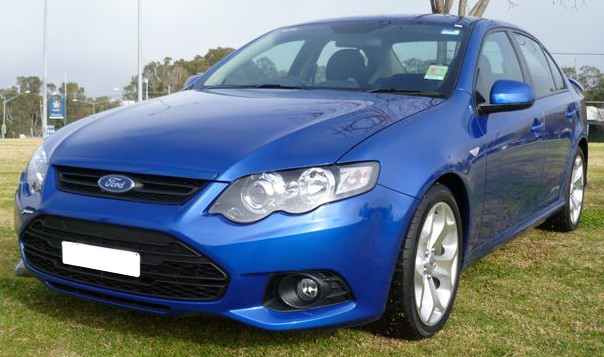 The FG, A completely new car, all new body lines, all new looks and all new power!! The FG was a complete different design from front to back; It was very curvy and very big. The new rear door lines offer more space for the rear occupants of the car to get in and out. The complete interior was upgraded and made much roomier. A new plastic intake was added to the Barra 4L engines and other small things were also done to the motor in order to give it a little more power. The XR6 Turbo gained power and got up to 270kw, and the XR8 now had a big Boss 290. The FG MKII was release in early 2012; it had all new front end designs and a new ICC. The new ICC had a bigger color screen through all models and it was touch screen too. For the first time Fords factory gas engine had the new injection set up. The new set up combined with a 6 speed auto gave the EcoLPI Falcon quicker take off then the standard petrol. For the first time the Falcon is offered with a 4 cylinder turbo motor known as the EcoBoost. The EcoBoost Falcon is much quieter then the standard 6 cylinder Falcon but goes just as well. The FG Falcon is by far the most technologically advanced Falcon and they are built strong and tough.
The FG, A completely new car, all new body lines, all new looks and all new power!! The FG was a complete different design from front to back; It was very curvy and very big. The new rear door lines offer more space for the rear occupants of the car to get in and out. The complete interior was upgraded and made much roomier. A new plastic intake was added to the Barra 4L engines and other small things were also done to the motor in order to give it a little more power. The XR6 Turbo gained power and got up to 270kw, and the XR8 now had a big Boss 290. The FG MKII was release in early 2012; it had all new front end designs and a new ICC. The new ICC had a bigger color screen through all models and it was touch screen too. For the first time Fords factory gas engine had the new injection set up. The new set up combined with a 6 speed auto gave the EcoLPI Falcon quicker take off then the standard petrol. For the first time the Falcon is offered with a 4 cylinder turbo motor known as the EcoBoost. The EcoBoost Falcon is much quieter then the standard 6 cylinder Falcon but goes just as well. The FG Falcon is by far the most technologically advanced Falcon and they are built strong and tough.

History of Ford Falcon





